 Bomber Command
Bomber Command  |
Aircrew Chronicles
|
Aircrew Losses
|
Nose Art
|
BCATP
|
Lancaster
|
Media
|
Aircrew Chronicles
|
Aircrew Losses
|
Nose Art
|
BCATP
|
Lancaster
|
Media
 Bomber Command
Bomber Command  |
Aircrew Chronicles
|
Aircrew Losses
|
Nose Art
|
BCATP
|
Lancaster
|
Media
|
Aircrew Chronicles
|
Aircrew Losses
|
Nose Art
|
BCATP
|
Lancaster
|
Media
During the 1930's great strides were made in the development of powered gun turrets in the belief that they would be capable of defending bombers from fighter attack. They were technologically advanced for the time, fully enclosed and providing the air gunner with more firepower than ever before. However with the advent of war, it became obvious to Bomber Command that formation flying during the day, even with the latest turrets, would not provide protection for the bombers from swift, heavily armed fighter aircraft. The British turned to night bombing but the air gunner's role remained the same, that of the primary lookout and protector of the aircraft and the lives of those aboard.
|
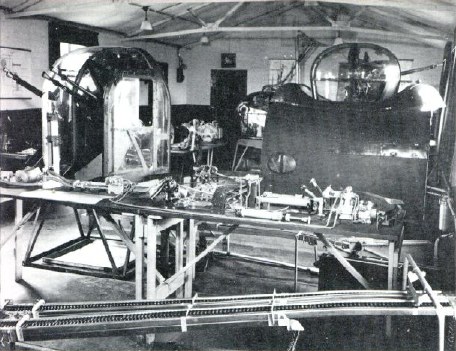
|
Almost all Lancasters were equipped with three Frazer-Nash (FN) hydraulically operated turrets, each with .303 calibre machine guns. The FN-5 nose turret had two guns, the FN-50 mid-upper turret had two, and the FN20 tail turret had four. The FN64 mid-under turret saw only limited use in the aircraft's early months. The nose turret was rarely used and manned by the bomb aimer if required. Some of the later Canadian-built Lancasters (those from serial # KB-855 on), including the museum's aircraft, were equipped with the American built, electrically powered Martin 250 mid-upper turret with twin .50 calibre guns. Few, if any, of these saw service.
The Halifax used a variety of Boulton Paul turrets in the nose, mid-upper, and rear positions. The mid-upper was initially armed with twin .303's but later versions carried four guns.
After flying Wellingtons with 331 Wing RCAF in North Africa, 420 Squadron and 431 Squadron were re-equipped with Halifaxes that were equipped with min-under or ventral gun turrets that were mounted aft of the bomb-bay, where the H2S radar dome was located on all other four-engined Bomber Command aircraft.
The Short Stirling was equipped with Fraser-Nash turrets, an FN5 in the front and FN20 at the rear. The Mk I Stirlings carried an FN7 mid-upper whereas the Mk III's carried and FN50.
Most of the twin-engined Wellingtons utilized Frazer-Nash turrets, an FN-5 front turret and an FN-20 rear turret.
The majority of Blenheim bombers were equipped with a Bristol B-1 mid-upper turret that carried twin .303 guns. Many had a Fraser-Nash FN-54 turret mounted below the nose and operated by the bomb aimer using a periscopic sight.
Most Whitleys were only equipped with a single Frazer-Nash rear turret that carried two .303 machine guns.
The Hampden was not equipped with a gun turret. It did carry two Vickers K-guns on Rose mid-upper mountings.
The swift and high-flying Mosquito did not carry any defensive equipment.
Like the Lancaster, the Manchester was equipped with Frazer-Nash turrets in the nose, mid-upper, and rear positions.
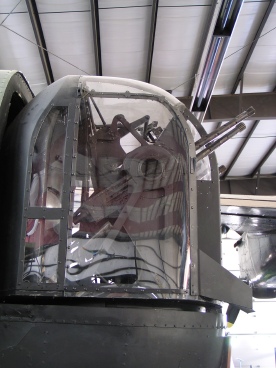
|
The Frazer-Nash FN121 Mk1 is an hydraulically operated turret containing four .303 calibre Browning machine guns. 10,000 rounds of ammunition were stored in four boxes which were placed in the rear fuselage and connected to the turret by a series of tracks. Turrets such as this were used on virtually all Lancasters that saw action during the war. Stirlings, Wellingtons, and Whitleys were defended by this type of gun turret as well. The rear gunner entered the turret from the fuselage, clipping his parachute to hooks just outside the turret. It was a very cramped location and it was necessary for some gunners to place their boots in the turret prior to climbing in. Once in the turret the gunner was unable to leave until the aircraft returned to base. The rotation mechanism, gun elevation, and triggers were hand operated. If the aircraft had to be abandoned the gunner had to open the turret doors behind him, reach for and clip on his parachute, rotate the turret 90 degrees, and then fall out backwards. |
When operating on night operations at low temperatures the air gunner's view was often restricted by frost forming on the plexiglass. It became common, despite the added discomfort, for gunners to remove the centre panel of glass to ensure good visibility.
The museum's turret was acquired by Alvin Berger of Nanton and parts from two others were used as well. Its restoration to operational status was spearheaded by Society members Larry Wright and Bill Howe.
A second example of the Frazer Nash Rear Turret is on display in the museum. Although missing many of its components, this turret is equipped with an articulated armoured screen that was fitted to some later versions of the turret. As the armour plates had a tendency to jam in its tracks, some squadrons had it removed in favour of additional ammunition.
The Martin 250 CE is a 24 volt, electrically operated turret containing two .50 calibre machine guns. Four ammunition boxes provide 1600 rounds of ammunition. It was mounted on the top of the aircraft, about mid-way down the fuselage. This turret was used on American bombers such as the A-20 Havoc, B-24 Liberator, B-17 Flying Fortress, and B-26 Marauder. During the war, the Royal Canadian Air Force realized the limitations of their .303 calibre machine guns and took steps to switch from the hydraulically operated Fraser-Nash mid-upper turrets to the Martin. However, this modification was only included on the last 276 of the 431 Canadian built Lancasters. |
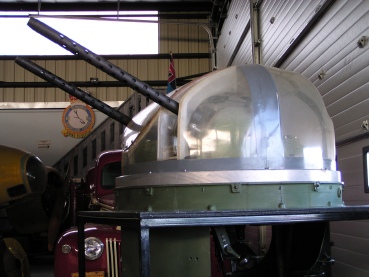 |
The turret on display in the museum is from a No. 420 (Snowy Owl) Squadron Lancaster and was "liberated" from the Pearce, Alberta RCAF base as the No. 420 Squadron Lancasters were being scrapped shortly after the war. It was donated to the Nanton Lancaster Society by Peter Berger of Lethbridge. Although the turret is complete and moves with its manual control handles, the electronic components are not operational. Its restoration team was led by Milt Magee and Leonard Hoffarth.
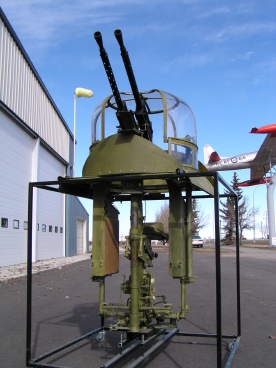
|
This was the first in a series of Bristol designed turrets that were fitted on Bristol Blenheim and Bristol Beaufort aircraft. As well, they were placed on the Canadian built Bolingbrokes. A unique feature of this turret was that, when not in use, the cupola could be partially retracted to reduce drag. Initial versions utilized a single Lewis gun that was later replaced by twin Browning .303's. At that time an apron of 0.9 mm armour plate was fitted to the rear fuselage behind the turret. Parts for this restoration were taken from a number of Bolingbroke aircraft recovered by the Society. Its restoration is under the direction of Charlie Cobb. |
Like all Frazer Nash turrets, the FN-50 was hydraulically operated. It was equipped with two .303 machine guns and carried 2000 rounds of ammunition. A system was developed to make it impossible for the mid-upper gunner to fire into the Lancaster's rear stabilizers and rudders. In 1991, the museum's turret was restored to operational status while in Montreal to be used in the movie, "Map of the Human Heart." This turret is currently mounted on the aircraft. |
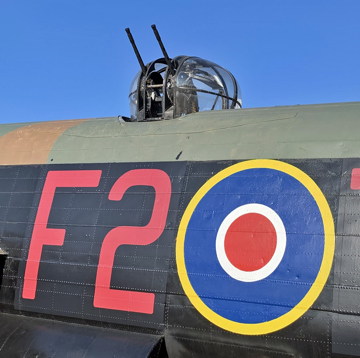 |
This partially restored turret is mounted in place at the front of the museum's Lancaster. The nose gunner sat on an adjustable metal seat when operating the turret. Its restoration was spearheaded by Peter and Paul Whitfield of Sarnia, Ontario. |
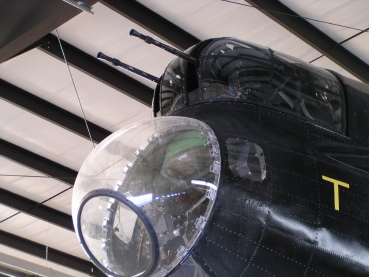 |
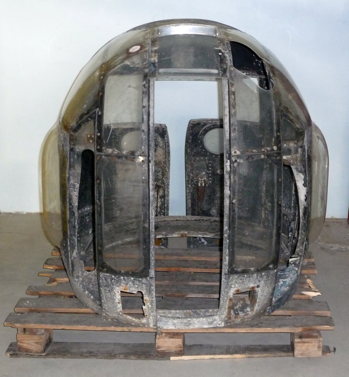
|
Boulton-Paul turrets were electro-hydraulic -electric motors located in the turret drove hydraulic pumps that powered hydraulic motors and rams. This was more effective than electric motors alone and did not require power developed by the aircraft's engines as did the hydraulic system utilized by Fraser-Nash turrets. The metal framework, access doors, some of the Perspex, and numerous parts for this Halifax rear turret were located in England in 2007. Arrangements were then made for their acquisition by the museum and to have them shipped to Nanton. The turret awaits restoration and is part of the museum's 'Halifax project'. |